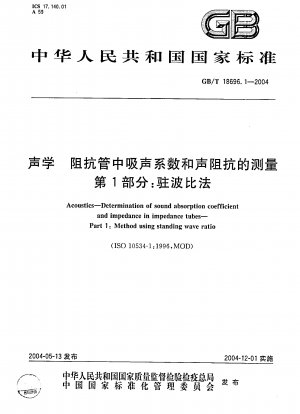GB/T 18696.1-2004
Acoustics-Determination of sound absorption coefficient and impedance in impedance tubes-Part 1:Method using standing wave ratio (English Version)
- Standard No.
- GB/T 18696.1-2004
- Language
- Chinese, Available in English version
- Release Date
- 2004
- Published By
- General Administration of Quality Supervision, Inspection and Quarantine of the People‘s Republic of China
- Latest
- GB/T 18696.1-2004
- Scope
- 1.1 This part of GB/T 18696 specifies the method for determining the sound absorption coefficient, reflection factor and surface acoustic impedance or surface acoustic admittance of sound-absorbing materials and structures at normal incidence. It is determined by the standing wave diagram generated by the superposition of the incident sine plane wave and the plane wave reflected from the specimen under the incident condition. Because only a small amount of sound-absorbing material is needed as a test piece, it is especially suitable for the parameter research and design of sound-absorbing materials. 1.2 The method of this standard has some important differences compared with the method for measuring sound absorption coefficient in reverberation chambers (see ISO 354). The impedance tube method can be used to determine the sound absorption coefficient, and can also be used to determine the acoustic impedance rate or the acoustic admittance rate. This method stipulates that the sound wave is normal to the incident surface of the test piece. The reverberation chamber method (under ideal conditions) measures the sound absorption coefficient of random incidence. The impedance tube method is based on the existence of an incident plane acoustic wave, under which conditions it can give accurate measurements (except for measurement errors and installation errors). The determination of the sound absorption coefficient in the reverberation chamber is based on some simplified and approximate assumptions about the sound field and the size of the specimen, so sometimes a sound absorption coefficient greater than 1 is obtained. The impedance tube method requires the specimen to be as large as the cross-section of the impedance tube. The reverberation chamber method requires relatively large specimens, and the reverberation chamber method can also be used for specimens with significantly inhomogeneous structures in the transverse direction and/or vertical direction of the surface. Measurements made on such inhomogeneous specimens in impedance tubes must be interpreted carefully (see 9.1). Refer to Appendix D for the calculation method of converting the test results of the impedance tube method (normal incidence) into random incidence conditions. 1.3 Since all laboratories are equipped with computers, this part adopts the numerical calculation method instead of the graph search method. Certain quantities in the formulas in this section are complex numbers. Arguments of trigonometric functions expressed in radians
GB/T 18696.1-2004 history
- 2004 GB/T 18696.1-2004 Acoustics-Determination of sound absorption coefficient and impedance in impedance tubes-Part 1:Method using standing wave ratio
